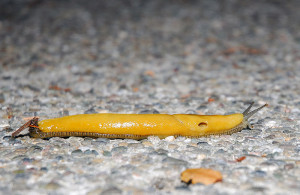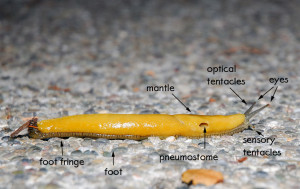It’s fall, and we’ve noticed the banana slugs are more active around the property again, no doubt due to the cool damp weather. Slugs are not usually favored in most gardens but, with a little research, we’ve come to realize these are actually beneficial creatures, albeit often misunderstood.
Banana slugs are terrestrial mollusks of the genus Ariolimax. They are native inhabitants of Northwestern North America, found in the coastal regions of California, Oregon, Washington, Alaska, and Canada.
There are presently three recognized species of banana slug. Ariolimax columbianus (Pacific banana slug) the largest of the genus, Ariolimax dolichophallus (slender banana slug), and Ariolimax californicus (California banana slug). Banana slugs can range in color from white to near black, some (A. columbianus) may even be spotted. The banana slugs here at Curbstone Valley are predominately vivid yellow, and our recent visitor appears to be the slender banana slug (A. dolichophallus).
Recyclers and Protectors of the Forest
Banana slugs are detritivores, part of our team of resident recyclers of decaying plant matter, and animal wastes, along with the millipedes, pill bugs, and various species of worms and snails. Mushrooms are considered to be a particular delicacy in the banana slug diet. They reportedly will even consume poison oak, but redwood trees, including tender young saplings, are strictly off the banana slug’s menu. Banana slugs, prone to dessication in arid environments, have a mutualistic dependency on the redwood trees here, relying on the dense shade and moist atmosphere of our coastal redwood forests for their survival. The banana slug is actually an often overlooked, but nonetheless important part of this ecosystem, devouring other small plants and weeds that compete with young redwoods for space, light, water, and nutrients.
Ewwww…Slime
As land-based mollusks, banana slugs, like all slugs, secrete a slime. This serves many purposes, including facilitating locomotion and reproduction, aids in defense against predation, and prevents dessication. During the warm weather months the slugs are typically more nocturnal, foraging during the cooler and more damp evening hours. If their environment becomes particularly dry, banana slugs can estivate, by secreting a thick protective layer of mucus, and coating themselves with a layer of damp soil and leaves. In the autumn, once the rains return, they emerge from their state of torpor, and when the weather is more hospitable, especially during light rains, it is quite common to see them foraging during the day.
Beyond the Slime
Slug anatomy, if you take the time to look, is actually quite interesting. Banana slugs have two sets of tentacles on their head. As shown below, their eyes are located at the terminus of the longer optical tentacles, which can be rotated in all directions to enable the slugs to see over obstacles in their path. The shorter, ventrally oriented sensory and olfactory tentacles enable the slug to smell, and sense its way through the forest.
The banana slug, being a land dwelling species, is a pulmonate gastropod. Unlike aquatic gastropod species, they lack gills. Instead they have evolved a lung-like structure enabling them to respire on land. On the right side of the body there is a noticeable hole in the mantle called a pneumostome. This breathing pore is connected to the vascularized mantle cavity that functions as a lung, enabling the slug to breathe. This pore, only found on the right side of the slug, opens and closes cyclically, and may be difficult to observe when closed.
When You Can’t Run…Hide
Our seemingly defenseless banana slugs move very slowly, lack a protective shell unlike their snail cousins, and are very gentle creatures. Why then would these potentially easy meals for any passing predator, be colored a vivid, easy to see, highlighter-yellow? The banana slug’s yellow appearance, believe it or not, actually serves as camouflage in this environment. The farm is also host to another prolific species here, the California bay laurel tree (Umbellularia californica). The bay laurel is evergreen in this climate, but intermittently drops yellowing leaves throughout the year.
As you can see, these leaves are not only similar in their coloring to our resident banana slugs, they’re not too dissimilar in shape either.
Camouflage however isn’t always enough. Banana slugs do have a number of predators, including newts, and frustrated gardeners, but perhaps their most formidable natural predator in this part of California is the Coast Garter Snake (Thamnophis elegans terrestris). An interesting series of experiments by Steven Arnold in the early 1980’s demonstrated that the coast gartersnake seems to have a genetically based predilection for preying on banana slugs. Arnold compared the coast gartersnake’s diet choices to its cousin the mountain gartersnake (T. elegans elegans), and found the latter would rather starve, than eat slugs. Whereas the coast gartersnake seemed to relish them. Fortunately for the mountain garter, a resident of more arid climates, it is unlikely to ever encounter a banana slug. Barring predation, the banana slug’s life expectancy is believed to be between 3 to 6 years.
Banana Slugs-No Known Predators?

UCSC Banana Slug Logo
No discussion of banana slugs in Santa Cruz would be complete of course, without a brief mention of Sammy the Slug from our alma mater (yes we are former banana slugs ourselves). Sammy the banana slug has been the official mascot of the University of California Santa Cruz since 1986. UCSC’s sports teams have famously taunted their opponents while wearing shirts with the phrase “Banana Slugs-No Known Predators”. Catchy maybe, but clearly…they weren’t familiar with Arnold’s work!
We probably take these diminutive creatures for granted here, but if you’re fortunate enough to encounter one in your garden, or on a hike, don’t say ewwwww, just remember that they’re an important part of our redwood forest ecosystem, efficient nutrient recyclers and soil amenders, and serve as a critical food resource for other animals. They’re much more than just slugs…













